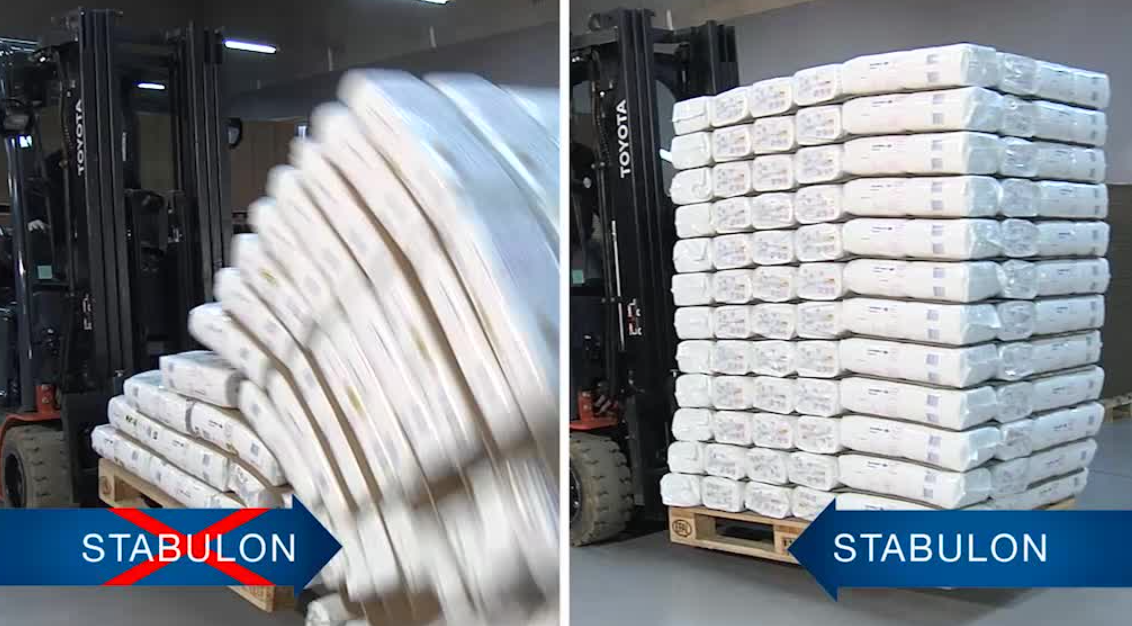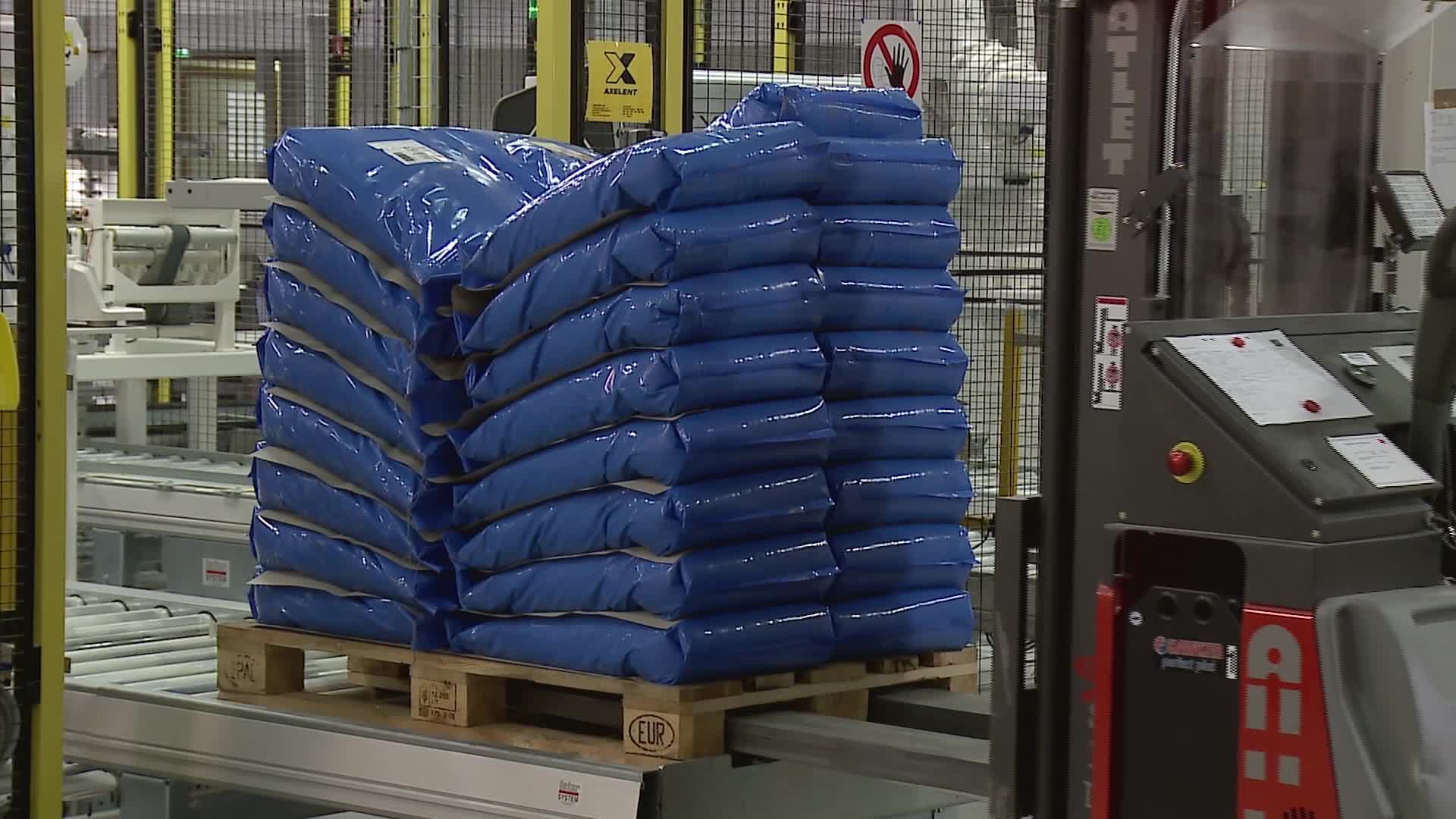Stabilizing industrial plastic bags on a pallet can be complex. So how to secure storage, transport?

Large and medium-capacity plastic bags and complex barrier bags are effective packaging. Specially suitable for powdery or small grain products. It is a reliable and economical packaging for transporting intermediate products or in large quantities.
But all these industrial bags or bags intended for the final consumer have a WEAKNESS: THEY SLIP !
Fortunately there are several techniques to stabilize industrial plastic bags effectively.
1- Why do your plastic bags slip?
- The bag is made of a slippery material
Bag made of a slippery plastic, migration of slippery additives, lamination with slippery films such as PVC, PP, use of slippery varnish. - The bag contains air or gas
On the bagging lines the air mixes with your product. Without perforations that allow air to escape, it remains trapped inside the bag when it is closed. In this case, the bag forms a balloon, and it then becomes very difficult to stabilize it. - Palletized bags are stacked in an anarchic fashion
This phenomenon is emphasized when the palletizing is manual.
When the palletizing pattern is crossed, then the layer is uneven and bags are unstable.
2- What are the different means of stabilization for industrial plastic bags:
- Make poly bags with a non-slip raw material
There are several methods of making a plastic non-slip bag. First of all, using adjuvants in the composition of the film. Or, the application of a varnish at the time of printing.
Unfortunately, these expensive methods do not always allow sufficient results to be obtained which modify the behavior of the bag on the pallet. Above all, a bag with anti-slip properties is very difficult to palletize on an automatic line at high speeds. - A deposit of palletizing glue
Palletizing glue application systems can be applied to this type of packaging. Nevertheless, it will be necessary to ensure:
The type of glue to use and its compatibility with the material of the bag (water based or vinylic).
The suitability for food contact of the adhesive for use on packaging lines for food products.
The palletizing rate available to absorb the drying time of the glue.
The configuration of the palletizing line and the possibility of adding a deposit system on the products.
The ability to find a space large enough for the storage system, for heating the glue.
Finally, your willingness to introduce new material that will need to be bought or rented. As well as the additional management of chemicals in your workshop that will need to be added to your HACCP audits.
- Anti-slip pallet dividers
The use of spacers makes it possible to resolve not only the sliding phenomena, but also makes it possible to secure the layers of bags. It is therefore no longer necessary to cross the layers at each level. Depending on the configuration, it will even be possible to carry out columnar palletization.
In most cases, it will therefore be possible to stabilize the pallet and increase the number of layers.
Thus, the palletization of plastic bags will be optimized.
Palletized bags will remain in place even after unpacking from the pallet.
You guarantee the good maintenance of the bags on the pallet until the product is consumed.

3- Palletizing glue for bags VS. Pallet Dividers: How Do They Compare?
To compare the solutions properly, you have to study all the advantages and disadvantages of the different solutions. Our teams suggest that you carry out a study of the total cost.
Contact our experts so that they carry out a complete audit of your problem with your teams.
CGP COATING INNOVATION, specialist in anti-slip coatings, offers innovative packaging solutions that respond to the instability of all types of packaging in BAGS.
Find a solution for all your types of SACS packaging.
Ensure that the bags are securely held on the pallet until the product is consumed.
Our STABULON® non-slip interlayer format is inserted between the rows of bags on the pallet. Its great flexibility allows it to optimize the surface in contact with the palletized bag.
The very high coefficient of friction of the STABULON® midsole prevents products from slipping. The non-slip midsole ensures great cohesion of the entire pallet.
Our anti interlayer format STABULON® anti-slip sheet is inserted on the bottom of the pallet and between the layers. It avoids the expense of moving during intra-logistics operations or transport.
This innovative packaging solution provides an answer to the problems of packaging your products in plastic bags:
- Increase the height of your pallets.
- Stabilize a columnar palletizing scheme.
- Preserve the integrity of your bag, a vector of communication.
- Guarantee impeccable palletization after opening the pallet.
- Secure your pallets after opening.
- No risk of tearing the bag.
- Reusable.
- Effective immediately, unlike glue.
- Standard coating is effective on all materials, unlike glue.
